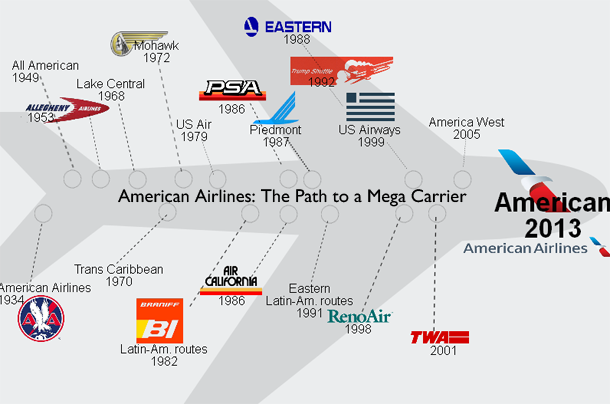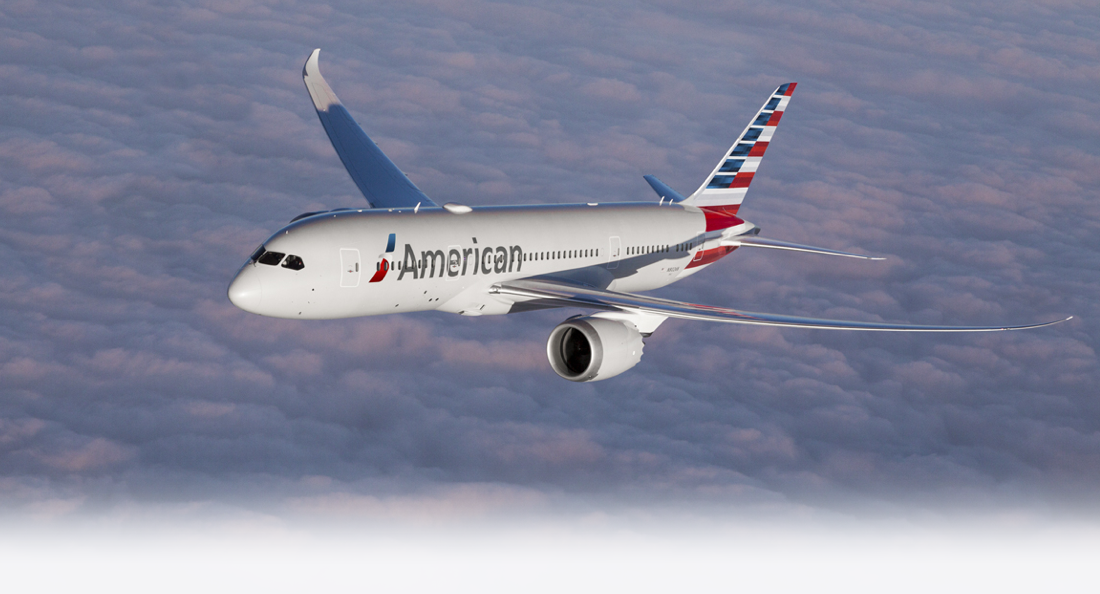In 2013, American Airlines and US Airways merged to form American Airlines Group, Inc. With its main headquarters in Ft. Worth, TX, the brand is globally recognized as a major network carrier that provides air transportation for passengers and cargo; it is also considered to be the world’s largest airline (by fleet size).
In addition to providing air transportation under the popular name, American Airlines, AAL includes other operations as well; for example, it operates a regional carrier service under the brand, American Eagle, which includes Envoy Aviation Group, PSA Airlines, and Piedmont Airlines, and third party carriers such as Republic, Mesa, Compass, and SkyWest. It also provides cargo transportation.
The airline operates through hubs in Chicago, Charlotte, London, Dallas, Los Angeles, Miami, Philadelphia, New York, Washington, DC, and Phoenix. By the end of 2020, the air carrier provided service for roughly 204 million passengers and operated 956 airplanes with an additional 595 planes through its regional and third-party carriers.
AAL is a founding member of the OneWorld alliance, which, by partnering with other airline carriers throughout the world, is able to readily facilitate service to more than 1,000 destinations in over 150 countries. According to the airline’s 2018 annual report, total sales for the year came to $44.5M; total expenses were $41.9M—consisting mostly of salary/wages and fuel-related charges; and net income for the year amounted to $1.4B, which was down compared to three of the last four years—with a slight improvement over 2017.
While neither a vision nor a mission statement could be found, a handout from the AAL’s annual leadership conference in January 2019 describes three strategic objectives of the company: Make Culture a Competitive Advantage, Build American Airlines to Thrive Forever, and Create a World-Class Customer Experience. In addition, the company states in its latest 10-K filing, “Our business plan contemplates continued significant investments related to modernizing our fleet, improving the experience of our customers and updating our facilities”.

History
American Airlines’ rich and colorful history has been intertwined with American aviation for nearly 90
years. In the 1920s, America was recovering from World War I, the first war to see major use of planes
in the offensive, defensive, and reconnaissance missions.
As the stories of aviator war heroes spread and the aviation industry propelled forward, Americans saw aviation as a sign of better times, of advancement, and of prosperity. As more young men and women were drawn to the field, innovators pushed planes to new limits, and the utility of aviation was discovered.
The U.S. Government began contracting companies for mail delivery, and entrepreneurs saw business opportunities in both mail delivery and then travel. Though the Wright Brothers already held a place in American hearts, figures like Charles Lindbergh and Amelia Earhart captivated the nation during this era as they daringly pushed planes to new and unforeseen limits.
In addition to being the first to make a solo flight across the Atlantic in 1927, Charles Lindbergh was
the chief pilot for Robertson Aircraft Corporation of Missouri, a mail carrier. In 1929, the Aviation Corporation formed to acquire young aviation companies, including Lindbergh’s.
The Aviation Corporations eventually incorporated into American Airlines in 1934. By 1937, American had carried its one-millionth passenger, and in 1939 American Airlines began trading on the New York Stock Exchange. By the end of the 1930s, American became the nation’s number one domestic air carrier in terms of revenue passenger miles.
By the end of 2001, American Airlines acquired TWA and became the largest commercial airline in the United States. American Airlines was soon the largest domestic carrier and one of the most profitable airlines of the century.
On September 11, 2001, two AA aircraft were hijacked and crashed during the terrorist attacks in the United States. The terrorist attacks also damaged AA’s financial stability.
Timeline
1936: American is the first to fly the DC-3 commercial flight from New York to Chicago.
1939: US Airways (later American Airlines) is founded in Pittsburgh, Pennsylvania.
1957: American opens the world’s first facility for flight training in Dallas/Ft. Worth.
1981: American introduces AAdvantage, the first of the airline loyalty programs.
1991: American celebrates its one billionth customer.
2001: American loses 23 people in the tragic events of 9/11.
2015: American and US Airways merge as one airline.
Brand and marketing strategies
In 2012 American Airlines began to understand the importance of building customer loyalty and worked towards restoring its relationships with potential customers and especially long-time customers. American Airlines developed an integrated marketing communication plan that had the use of social media, community events, and rebranding efforts to improve its reputation through marketing and PR with the aim of improving the public’s point of view for the airline that continues today.
Social Media: The airlines have focused their efforts on social media and with the campaign called, “The World’s Greatest Fliers”, they aim to appreciate their long-time customers and specifically their target audience which includes men and women of the business world. Simultaneously, the campaign invites all types of fliers to American Airlines by assuring them that the airline welcomes them wholeheartedly and has created an environment meant for all travelers.
Community Events: The airlines have been hosting Celebrity Ski, an event dedicated to raising
funds for Cystic Fibrosis for the past 32 years. The company has teamed up with three sisters living with the disease and aims to try and find a cure. The team donates all proceeds that they get from the event to help find a cure for Cystic Fibrosis.
Rebranding: From 2012 to 2017, American has made a significant change in the way they market the airlines, i.e., focusing more on customer needs and concerns as well as offering changes from direct customer feedback.
Also Read: Tesla – The Saga of Creative Ideas Continues
In 2013 the marketing team launched the campaign, “Change is in the air” and wanted to bring the “Wonder of Travel back.” After dealing with steep financial issues, the airline changed to its logo and aesthetic for the first time in 45 years in a major rebranding effort to modernize the company. In addition, the company also purchased new planes dawning the new logo, and look to improve flying comfort for customers.
Advertising and Promotion: American Airlines is doing its best to show that it is indeed the best airline in the world. It launched the new campaign called “The world’s greatest flyers fly American.” which aimed to teach its customers not only that they are the greatest flyers, but also that this is how the greatest flyers fly which aimed to attract more business flyers to the airline.
American is working hard to rebrand its social media image into one that is positive. It understands that the world is changing and that social media is important so it is making extensive use of the hashtag #greatestflyers so that customers could use that when they saw good things happening lately with the flyers flying with the airlines.
American also continues to do great things in the community. In 2016, they were able to raise 2.5 million dollars for veteran and military initiatives at the annual Skyball event in Dallas-Fort Worth. In addition to that, American raised $1.3 million for the Susan G. Komen Young Investigator Grant program.
Targeting high-end customers: AA targets high-value customers, individuals who fly often, and purchase first-class and business-class tickets hence places high-premium on each ticket bought. A successful campaign in 2014, American ran with the big idea of “Going for great.” It invoked the company’s effort to strive for continuous improvement in the customer experience. This campaign also addressed the then-recent merger of American Airlines and US Airways and publicized the company’s purchase of an Airbus A321 aircraft.
This rebranding was revolutionary and focused on every single problem that had plagued the company. Taking a strategic approach to air travel, American has proven that like the phoenix, the American Airlines Eagle can rise from the ashes.
To read more content like this, subscribe to our newsletter.
Go to the full page to view and submit the form.


